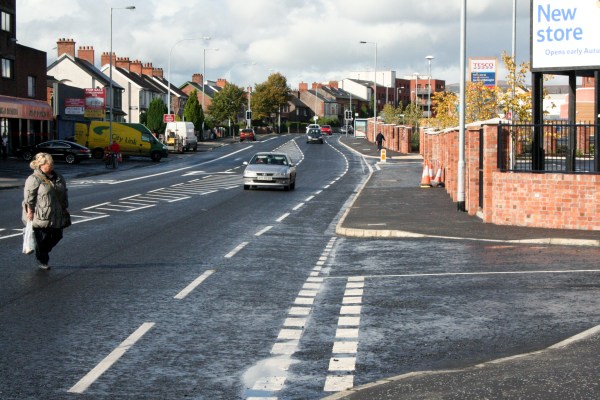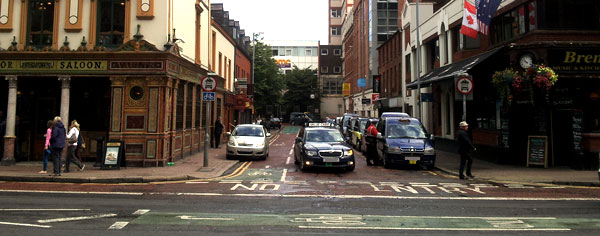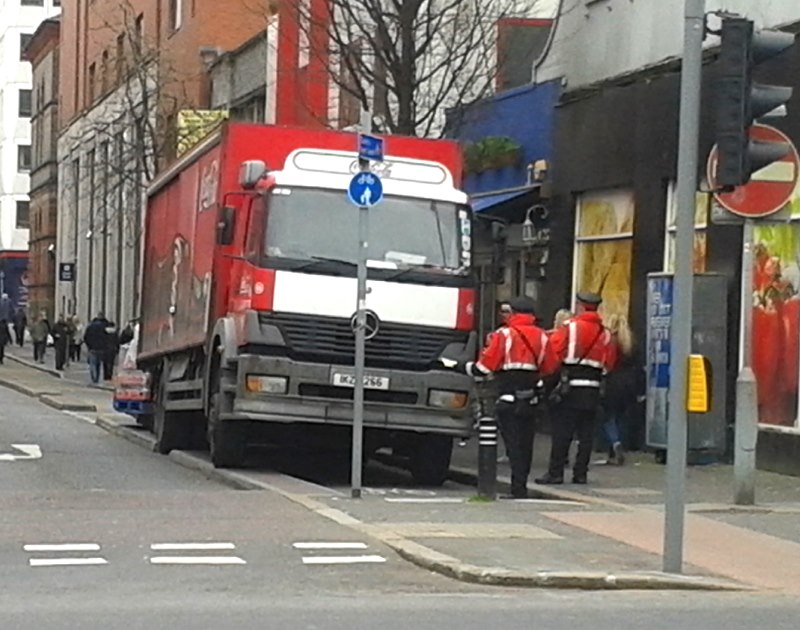In July 2012 Belfast cyclists joined together to highlight the problem of the city’s blocked cycle lanes. QUB researchers analysed the data from 69 journeys, with a typical commuter trip blocked 5 times, or 4.5 illegal blockages per km of supposedly parking-restricted lanes. The issue was highlighted in the media, to politicians, the Regional Development Committee at the NI Assembly and DRD / Roads Service. Now that Roads Service have provided their response it’s time to review a busy month for the Reclaim Belfast’s Cycle Lanes report.

The media response
The story was picked up by two big fish in the local newspaper market, the Belfast Telegraph under the headline Cyclists demand action on illegally parked car chaos and also in the Irish News with their story Cycle lane investment ‘wasted public money’. In particular the Belfast Telegraph’s comments sections provided a great opportunity for feedback and discussion, and 40 comments here showed the depth of feeling – worth a read!
The lovely people at View TV Belfast ran with a report Cycle lanes a waste of public money including some actual survey footage from the Springfield Road, coincidently the worst performing road in the survey.
NI Greenways somehow managed to blag its way on on to Radio Ulster’s Talkback show, where even black taxi drivers were phoning in to support cyclists!
Fortunate timing allowed the report this media space on its own merits, ahead of the two big roads issues of the past month, the taxis in bus lanes consultation and the growing pains of the Belfast on the move project.
The Twitter response
Debate on Twitter was lively as always, with generally positive comments on the survey and the potential of making a real difference to all road users. Some of the comments:
https://twitter.com/SteveLimmer/status/240468998544818176
https://twitter.com/DerSchwarzBaron/status/240825547607920641
https://twitter.com/ctokelly/status/239810163345870848
The political response
So far so good, but this report was designed with the sole purpose of making a real difference to the experience of commuter cyclists in Belfast. So the press releases were simultaneously sent to all Belfast City councillors (those with an email address), all MLAs from Belfast constituencies, the members of the Regional Development Committee at Stormont and DRD Minister Danny Kennedy.
The response, perhaps unsurprisingly, has been sluggish. Belfast councillors expressed the greatest interest in the report, with follow up questions and suggestions of a meeting – clearly with an eye on the Belfast Bike Hire announcement just days before. But just seven councillors from 45 contacted felt moved to respond.
Only six MLAs from 35 contacted have responded, with just one MLA following up with any real action – it doesn’t take a genius to figure out which MLA that was. Assembly questions have already been raised on the report, and answered (sort by Regional Development). The Regional Development Committee noted our correspondence on 12th September, and on the same day even began to question DRD’s Ciarán de Búrca on illegally parked cars! There is yet hope!
The Roads Service response
The private office at DRD deferred to Roads Service Eastern Division for comment, and the full text is attached below. To summarise the main points:
- Roads Service appreciates cyclists’ concerns
- A new contract with NSL for parking enforcement will see changes
- An awareness campaign on parking “Dos” and “Dont’s” will be launched to support a new protocol
- Enforcement will move to ‘tow and clamp’ from early 2013
While these are interesting developments, the response itself is very disappointing. It reads like a stock response to a complaint from a member of the public. Despite five long paragraphs on the finer points of Belfast’s cycle infrastructure, the strange emphasis on mandatory lanes leaves the impression that Roads Service didn’t fully understand (or perhaps even read) the survey report. The vast majority of illegally parked cars recorded in the survey were on advisory cycle lanes during urban clearway operational hours, and clearly these rules are the most confusing for all categories of road users.
The report drew a clear conclusion that Roads Service failure lies in “inadequate parking enforcement coverage”. Roads Service and their NSL contractors have all the necessary legal instruments in place to enforce parking restrictions – it’s just that the resources to cover all of the city’s main roads during rush hour are not being made available. As this video comparison from the survey week shows, mere visibility of traffic wardens is enough to clear arterial routes of illegal parking. Roads Service completely ignores this criticism.
Indeed, while new measures are being brought in, to what extent will they cover the whole of the city? A tow truck risks adding to the impression of motorists being beaten with another ‘stick’, as seen with the current city centre bus lane controversy. But is it one truck or two, or more? If the new towing policy can only cover the same number of routes as are presently patrolled by wardens, the situation on cycle lanes may not materially improve.
So no acceptance that illegal parking is a major problem for cyclists, or that Roads Service bears some responsibility for ineffective enforcement. Just a very bland corporate line that Roads Service’s advisory cycle lanes mean rush hour “cyclists effectively have their own road space. This makes cycling safer, and at times of congestion, allows cyclists to make time savings” – a stunningly absurd statement given the report which prompted the response.
What the traffic wardens say
You learn more about the actual situation in Belfast by talking to traffic wardens. They report that perhaps five teams at most work the rush hours on arterial routes, with one or two “mobile” units with access to a car. Look at the map and make your own judgement on how many Belfast roads count as ‘arterial’, but somewhere between 14 to 22 urban roads carry clearway restrictions, many with advisory cycle lanes. To ensure a ‘spread’ of traffic wardens, priorities for coverage are assigned on a week-to-week basis. Lisburn Road is always priority #1 (which goes some way to explaining why 27% of all parking tickets in Northern Ireland are issued here) with the Newtownards Road usually a close second in importance.
If your commuter route is elsewhere, good luck to you – coverage is patchy or in some cases almost non-existent. This explains why some roads are blocked every day – many drivers are either unaware there are restrictions or have never encountered a traffic warden who might tell them otherwise.
Traffic wardens are also having fun with some new training being rolled out to volunteers – on how to use a moped. Yes, apparently 12 moped-riding red coats will form part of the new NSL arrangements in 2013, which leads me to wonder if this is evidence of people actually reading my blog?
From here to where?
While there has been a small yet significant response to the report, it highlights the problem of so many previous cycling awareness or campaign initiatives in Belfast. Alone it’s an interesting piece of work, which quickly fades from the view of a disinterested body politic. Only by keeping the pressure on at the relevant levels can Belfast commuter cyclists hope to effect real change to an issue that causes increased physical danger, greater general traffic congestion, and discourages cycling uptake.
With that in mind, the most effective way to keep the issue high on the agenda is to run the survey again – bigger and better. If you’re interested in becoming a participant, and helping us the achieve the goal of 100% coverage of Belfast sometime in the next few months, contact NI Greenways by email or on Twitter @nigreenways.
Thanks again to all the commuter cyclists who participated in Reclaim Belfast’s Cycle Lanes, whether cycling the routes and recording data or helping to spread the message in the media or on social networks – and huge thanks to Mark Tully and his team at QUB for the main analysis.
That Roads Service response in full
I appreciate your concerns regarding the frustration caused to cyclists by vehicles that park within bus and cycle lanes during their operational hours. Perhaps it would be useful if I first outlined the type of facilities and the restrictions that apply to them.
Bus lane restrictions derive from specific legislation and prohibit the use of lanes by private cars, vans, lorries etc, during their hours of operation. Any infringements involving prohibited vehicles parking in those lanes are enforceable by Roads Service, through its contractor, NSL. Infringements involving moving vehicles within these lanes are enforceable by the PSNI.
Cycle lanes may be either advisory (which do not have supporting legislation and are not therefore enforceable) or mandatory (which have supporting legislation and are enforceable, similar to bus lanes as above). Advisory cycle lanes may be on roads that are subject to other restrictions, such as urban clearway restrictions, in which case those restrictions also apply to the cycle lanes.
We would normally use advisory lanes on roads with urban clearway regulations, so that when traffic levels and the number of cyclists are at their highest, cyclists effectively have their own road space. This makes cycling safer, and at times of congestion, allows cyclists to make time savings over those using vehicular modes.
During times when traffic levels are at their lowest, and the urban clearway restrictions do not apply, it is legally permissible to park on/across advisory cycle lanes. During these off-peak times, the levels of traffic and cyclists are at their lowest and it is therefore considered that cyclists can successfully share the remaining roads space. This arrangement is intended to provide the best balance between the needs of cyclists and the adjoining businesses/properties.
Mandatory cycle lanes (which would be marked by solid white lines) would provide a clear route for cyclists and would also restrict vehicles, subject to certain exceptions, from pairing along the road. However, the introduction of waiting restrictions, or mandatory cycle lanes, can be a contentious issue and would generally lead to a displacement of parking, often to other locations that are less able to accommodate it, such as residential streets in the general vicinity. Therefore, Roads Service does not generally use mandatory cycle lanes on roads with a mixed business/commercial/residential frontage.
Roads Service’s new parking enforcement and car park management contract with NSL Ltd will commence on 30 October 2012. In advance of this we plan to run a parking enforcement awareness campaign.
This will include the distribution of information leaflets to drivers to remind them of the importance of parking restrictions and the benefits of effective parking enforcement. The leaflet will include a number of “Dos” and “Don’ts” for drivers, advising them of where they should and should not park and it will clearly inform drivers not to park in mandatory cycle lanes.
Roads Service will also be publishing a parking enforcement protocol to provide the public with detailed information on the various parking contraventions that can be enforced by traffic attendants. This will also include information specific to mandatory cycle lanes.
Additionally, Roads Service has decided to change its enforcement policy in relation to illegally parked vehicles on bus lanes and urban clearways. Currently any vehicles parked in a bus lane or on an urban clearway will only receive a parking penalty, meaning the lane is still blocked to traffic. Following the introduction of the new contract Roads Service will also remove vehicles that are illegally in these lanes so freeing up the lane. It is hoped this change will be introduced in early 2013.



















